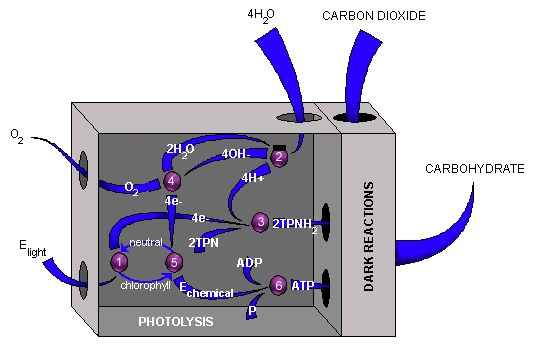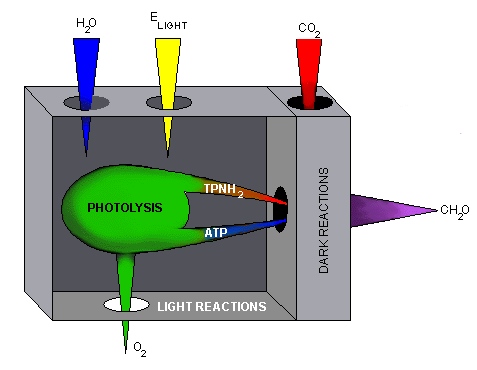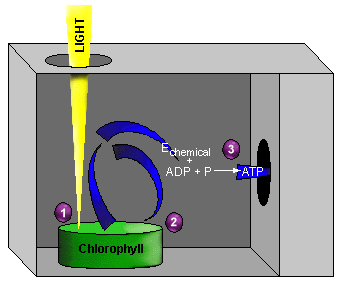Two Methods of ATP Production
Overview: Light is absorbed by chlorophyll which transfers the light energy into chemical energy ATP and NADPH +H. During this process water will be split and form oxygen. Oxygen is released as a by product for photosynthesis.
Plant cells can convert incoming radiant energy in the form of light to chemical energy in the form of high-energy molecular arrangements (energy rich molecules). This conversion is accomplished through the chemical reactions of photosynthesis. The overall photosynthetic process is one in which plant cells use energy to effect molecular rearrangements. Molecular groupings which have little energy are rearranged to produce high energy arrangements.
The details of the rearrangement process may seem difficult and strange to you, but the concept underlying the process is simple: the net result of all rearrangements is the production of energy- rich molecules. These molecules are "storehouses" of energy which can be used at a later time by the plant (or by creatures which consume the plant).
In this lesson you will study in detail the chemical reactions which occur during the light-dependent phase of photosynthesis. Read the pages indicated by E-17 and study behavioral objectives 32-37. These "light" reactions are driven by the incoming energy of sunlight, and the energy is transferred to the molecular products of the reactions. Two major processes occur which transform the incoming light energy to the chemical energy of energy storage molecules. Study this chart.
| Process | End Product |
| 1. direct production ATP molecules (for energy) of ATP | ATP molecules (for energy) |
| 2. photolysis of water | hydrogen (to build carbohydrate molecules)
ATP molecules (for energy) |
Arnon's experiments show that the energy needed for the above reaction (click one):
Shortly after his initial experiments, Arnon and his associated discovered a second way in which ATP forms in light. By means of experiments using radioactive tracers, this second reaction was demonstrated to occur during the photolysis of water.You should remember that photolysis is the part of photosynthesis in which the water molecule is broken into hydrogen and oxygen. Look at this reactant/product expression for light reactions:
To understand indirect ATP formation, you will need to examine
in greater detail the process of photolysis. This chart lists the important
molecules involved in photolysis and shows where they are obtained by the
plant cell.
| Molecules | Where the Molecules Come From |
| Water | Outside the plant through the roots |
| ADP | Made by the plant from AMP |
| (P) | From minerals in the soil |
| TPN | Made by the plant |
| Chlorophyll | Inside the plant cells in chloroplasts |

The first two reactions occur at the same time. Light enters the cell,
as does water. The fate of the light constitutes the first reaction, and
that of the water the second.
| Reaction #1: | The absorption of light by chlorophyll |
| Concept: | When light is absorbed by the chlorophyll molecule, one of the electrons in the molecule gains enough energy to break away. |
| R/P Expression: | Elight + chlorophyll ---> chlorophyll+ + e |
| Product: | A charged chlorophyll molecule and a free, high-energy electron. |
- a. chlorophyll
- b. light
| Reaction #2: | The ionization of water |
| Concept: | Water is constantly utilizing low levels of heat energy in order to split apart (ionize). This is a continuous process, with neutral water molecules splitting apart into two charged ions. The light reactions take advantage of this process to use the ionized hydrogen. |
| R/P Expression: | Eheat + H2O ---> H+ + OH- |
| Product: | Hydrogen ions and hydroxide ions, both available for subsequent reactions. |
| Reaction #3: | The formation of a carrier for hydrogen |
| Concept: | The "carrier" molecule formed in this reaction will transport hydrogen into the dark reactions of photosynthesis. This carrier molecule forms as the electrons produced in Reaction 1 and the hydrogen ions produced in Reaction 2 combine with a molecule found inside the cell. |
| R/P Expression: | 4e- + 4H+ + 2NADP ---> 2NADPHH2 |
| Product: | NADPH2 a neutral (no charge) molecule which has accepted, in addition to the hydrogen atoms and the free electrons, the large amount of energy carried by the electrons. |
| Reaction #4: | The reaction of several hydroxide ions to form a number of products, among which is oxygen gas. |
| Concept: | The OH- groups (from Reaction 2) react to produce two molecular products (oxygen and water) and free electrons. |
| R/P Expression: | 4OH- ---> 4e- + O2 + 2H2O |
| Products: | Electrons, oxygen, and regenerated water molecules. The water molecules can be ionized again (Reaction 2). |
| Reaction #5: | The capture of an electron by chlorophyll molecule |
| Concept: | Low-energy electrons from Reaction 4 that replace the high energy electrons which were lost by the chlorophyll during Reaction 1. |
| R/P Expression: | e- + chlorophyll+ ---> chlorophyll + Echemical |
| Product: | A regenerated neutral chlorophyll molecule which is ready to be activated by another dose of incoming light energy (Reaction 1). |
Reaction 5 is an energy-liberating reaction. The combining of
a chlorophyll molecule with an electron yields energy, and the cell uses
this energy to drive a very familiar reaction. Look at Reaction 6 in the
illustration. The cell uses Reaction 6 to (liberate/store)
the energy produced in the previous reaction.
| Reaction 6: | The formation of ATP during photolysis. |
| Concept: | The energy liberated in Reaction 5 can be used by the cell to rearrange ADP and (P) into ATP. |
| R/P Expression: | Echemical + ADP + (P) ---> ATP |
| Product: | ATP, an energy-rich storage molecule. |
You have now studied photolysis in greater detail and understand that it is composed of several reactions. You should be able to trace each of these reactions in the illustration.
Look at the overall photolysis reaction above.
- a. Which product of photolysis is carried into the dark reactions? (hydrogen/oxygen)
- b. Which product of photolysis is also a final product of photosynthesis? (hydrogen/oxygen)
The energy is stored in which two molecules?
Answer: ATP; NADPH2 (in either order)
This illustration summarizes how light energy is transformed in chemical
energy (in the form of high-energy molecules) by the photolysis light-reaction.
But it does not show the manner in which the light energy can be converted
to chemical energy by means of the process discovered by Arnon. Earlier
in the chapter you became acquainted with direct production of ATP
molecules by the cell. In that light reaction, the action of light on chlorophyll
liberates high- energy electrons which are used directly for production
of ATP rather than for photolysis. TPNH2 = NADPH

The set of reactions described above is where light energy is converted into chemical energy. At this point in time only plants (autotrophic organisms) are capable of carrying out this reaction. For this reason all heterotroic organisms are dependent upon plants to provide all energy rich molecules. Read the chapter on photosynthesis (light dependent reactions) again and study the following paragraph outlining in detail these steps. The light dependent reaction consist of the following reactions and pigments.
Photosytem I
Photosystem II
Chlorophyll "a"
Red Light (680 and 700)
In your notes draw the figure shown on the pages indicated by E-9 indicating the the flow of electrons through photosystem I and photosystem II as they produce ATP and NADPH. During photosystem II red light "680" is absorbed by special chlorophyll "a" pigments (P680) causing electrons to become excited and jump into an orbit further from the nucleus. These electrons are picked off by an electron acceptor which passes them to a cytochrome electrons transport system. The electron transport system is similar to the one studied for cellular respiration. The cytochromes electron system runs a proton pump. Read the section on chemiosmosis. This pump causes a proton (hydrogen ion or acid) gradient on two sides of the membrane located in the thylakoids of the chloroplasts which stimulates the enzyme ATPase to form ATP by means of the following reaction.
ATPase
ADP + P -----------> ATP + HOH
The electrons which are passed along this cytochromes are not used up but passed on the a second Photosytem , photosystem I. At the same time these electrons are passed to these special chlorophyll "a" molecules (P700) far red light "700" is absorbed which excites an equal number of electrons to a higher state similar to that of photosystem II. WHile they are in this state the electrons are picked off by an electron acceptor. These electrons are than passed to and enzyme which reduces NADP into NADPH + H by the following reaction.
E chemical + NADP + H ---------------> NADPH.
NADPH is a coenzyme similar to that of NADH you studied in cellular respiration. THis coenzyme can be used in two ways. First it con move through cytochrome system and generate 3 ATP like NADH or in the case of photosynthesis, it can be used to reduce organic molecules. This will be discussed on the next web page.
During the process described above electrons are being used up to provide energy in producing ATP and NADPH. These electrons must be replenished for the chlorophyll molecules to stay intact. THerefore another reaction occurs at the beginning of Photosytem II. During this reaction water is split releasing two electrons and forming oxygen gas. This represents the oxygen released during photosynthesis.
Place the following events which occur during the light dependent reactions
in one of the two photosystems.
| ///////////////////////////////////////// | Photosystem I | Photosystem II |
| oxygen produced | ||
| ATP formed | ||
| NADPH formed | ||
| utilizes (red) 680 light | ||
| utilizes (red) 700 light |
Cyclical ATP Production
 . The
direct production of ATP discovered by Arnon and his associates is illustrated
in detail in the black box diagram above.
. The
direct production of ATP discovered by Arnon and his associates is illustrated
in detail in the black box diagram above.
Direct production of ATP is called cyclical ATP production because of the path of the electron that is liberated from the chlorophyll molecule. The path is cyclical only in the sense that the electron does not enter into other chemical reactions but returns directly to chlorophyll. (It does not necessarily return to the same chlorophyll molecule from which it was liberated.)
Three reactions make up cyclical ATP production.
- Step 1: Elight + chlorophyll ---> chlorophyll+ + e-
- Step 2: chlorophyll+ + e- ---> chlorophyll + Echemical
- Step 3: Echemical + ADP + (P) ---> ATP
All steps in cyclical ATP production are also chemical reactions employed in the non- cyclical process of photolysis. Specifically, Step 1 and Reaction 1 are the same; Step 2 is Reaction 5; and Step 3 is Reaction 6.
Both methods of ATP production convert energy in the form of light to molecular arrangements high in potential energy. This stored energy is called chemical energy.
The plants of the earth have evolved the mechanisms for converting sunlight into usable energy. During the light reaction, of photosynthesis, plant cells produce high-energy ATP and NAD molecules. These substances enter as reactants into the series of reactions which are the subject of the next web page. By way of these subsequent chemical reactions, the plant cells put the energy store of the ATP and NADH2 into "long-term storage" in the for of carbohydrate molecules. Re-examine the equation for photosynthesis which was given in the last web page..
After learning the light dependent reactions, you can rewrite
the equation above as follows:
Elight (chlorophyll)
ADP + NADP +6CO2 +
6H2O + ----> 6O2 + 6C6H12O6
+
ATP + NADPH
Note and explain the changes and write in your notes.
This is the end of lesson eleven. Click here to go back to the home page and lesson twelve: Photosynthesis- Dark Reactions. click
Created by the Multimedia Development Lab, Academic Television Services.
Last modified October 29, 1997.